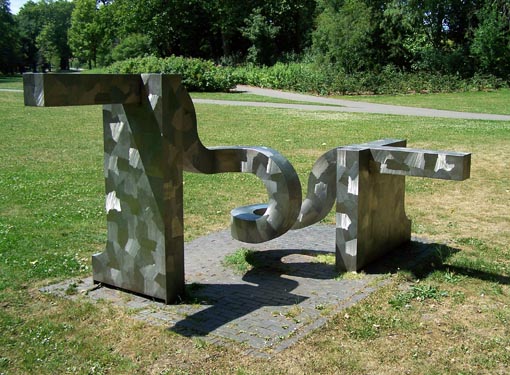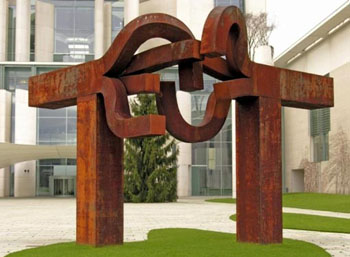Artist:
Jan Baetsen
Title:
Verbinding 3
Year:
1986
Adress:
Rijsterborgherpark, Deventer
Speels draaiende lijn
Bij Verbinding 3 van Jan Baetsen zie ik allereerst een speels draaiende lijn. Deze lijn verbindt twee rechthoeken die rechtop staan. Ik kan mij voorstellen dat het kunstwerk over verbinden gaat. ‘Verbinden’ is een mooi woord; dit is altijd en steeds weer nodig.
Ik snap niet zo goed waarom het oppervlakte van Verbinding 3 van Jan Baetsen verschillende kleurvlakken heeft. Door de vergelijking met een werk van Chillida, Matschinky-Denninghoff en De Vries zie ik nu dat het werk van Jan Baetsen te statisch is. Doordat de verbinding tot stand is gebracht ontbreekt het verlangen ernaar.
By Theo, www.artatsite.com
Vergelijking met andere werken
Bij Berlin van Eduardo Chillida (Berlijn, afbeelding 1,meer informatie) ontmoeten twee vergelijkbare vormen elkaar. Zij staan op een stevig been. Hun vingers steken vooruit en enkelen vinden elkaar ook (bijna). Het verroeste oppervlakte duidt erop dat de elementen doorleeft zijn.
In het kunstwerk zijn er veel spanningen: door de (kleine) verschillen tussen de vormen, door de dikke en dunne lijnen, doordat lijnen elkaar nét niet raken.
Berlin van Eduardo Chillida maakt de moeite invoelbaar als stevige elementen elkaar op een zachte manier ontmoeten. Als het beeld wil wijzen op pijn, moeite maar ook een duurzaam verlangen, dan is dit kunstwerk goed geslaagd.
Berlin van Matschinsky-Denninghoff (Berlijn 2, afbeelding,meer informatie) heb ik al vele keren gezien en is voor mij een dierbaar kunstwerk. Ik zie twee glimmende vormen die elkaar voorzichtig naderen van grote afstand en elkaar héél dicht naderen. Door de kromming is duidelijk dat de verbinding tot stand komt (niet verbroken wordt); de lijnen zijn bezig om naar elkaar toe te bewegen.
Met eenvoudige hulpmiddelen drukt Berlin van Matschinsky-Denninghoff een krachtige boodschap uit: een verbinding wordt gemaakt. Doordat het kunstwerk op een belangrijke weg in het centrum van Berlijn staat, handelt het onvermijdelijk over Oost- en West-Duitsland. Toch maakt de universele beeldtaal duidelijk dat veel andere verbindingen uitgedrukt worden.
Auke de Vries legt met Maasbeeld (Rotterdam 3, afbeelding,meer informatie) verbindingen tussen elementen die schijnbaar niets met elkaar te maken hebben. Ik zie een bal, een staaf, een kubus, een gekrulde vorm. De vormen liggen op kiepen, buigen, draaien of kantelen.
Dit speelse en spannende sculptuur maakt duidelijk waar de stad behoefte aan heeft. Dit kunstwerk is een goede toevoeging in een stad als Rotterdam met veel hard-werken, handel drijven, functionaliteit.
By Theo, www.artatsite.com
Translation
Playful turning line
The first thing I see in Connection 3 by Jan Baetsen is a playful turning line. This line connects two rectangles which are standing upright. I can imagine that this artwork is about connecting. ‘Connecting’ is a nice word; this is needed always and ever again.
I do not fully understand why the surface of Connection 3 by Jan Beatsen has different colours. Because of the comparison with a work by Chillida, Matschinky-Denninghoff and De Vries I now see that the work by Jan Baetsen is too static. I miss the desire, now the connection is finished.
By Theo, www.artatsite.com
Compared with other works
In Berlin by Eduardo Chillida (Berlin, picture 1, more information) two almost similar shapes meet each other. They stand on a sturdy leg. Their fingers are sticking forward and some of them seem to find each other (almost). The rusty surface indicates that the elements have a long experience.
The artwork has many tensions: because of the (minor) differences between the forms, because of the thick and thin lines, because of lines which almost touch each other.
Berlin by Eduardo Chillida makes me feel the troubles when solid elements meet on a gentle way. If the sculpture is to indicate pain, trouble, but also a lasting desire, then this artwork is well realized.
I’ve seen Berlin by Matschinsky-Denninghoff (Berlin, picture 2, more information) many times and for me it’s a precious artwork. I see two shiny forms which are carefully approaching each other from a large distance and meet each other very closely. The curvature makes clear that the connection is becoming (not breaking); the lines are in the process of moving towards each other.
With the use of simple tools Berlin by Matschinsky-Denninghoff is expressing a powerful message: a process of connection is happening. Because the artwork is located on a major road in the centre of Berlin, it is inevitable that it’s about meeting East- and West-Germany. Yet the universal visual language makes clear that many other connections are expressed.
Auke de Vries is making with Maasbeeld (Rotterdam, picture 3, more information) connections between elements that have seemingly nothing in common. I see a ball, a rod, a cube, a curled shape. The shapes tilt, bow, swivel or turn.
This playful and exciting sculpture makes clear what is needed in the city. This artwork is a good addition to a city like Rotterdam, where above all there is al lot of hard-working, dealerships, functionality.
By Theo, www.artatsite.com
Bij Verbinding 3 van Jan Baetsen zie ik allereerst een speels draaiende lijn. Deze lijn verbindt twee rechthoeken die rechtop staan. Ik kan mij voorstellen dat het kunstwerk over verbinden gaat. ‘Verbinden’ is een mooi woord; dit is altijd en steeds weer nodig.
Ik snap niet zo goed waarom het oppervlakte van Verbinding 3 van Jan Baetsen verschillende kleurvlakken heeft. Door de vergelijking met een werk van Chillida, Matschinky-Denninghoff en De Vries zie ik nu dat het werk van Jan Baetsen te statisch is. Doordat de verbinding tot stand is gebracht ontbreekt het verlangen ernaar.
By Theo, www.artatsite.com
Vergelijking met andere werken
Bij Berlin van Eduardo Chillida (Berlijn, afbeelding 1,meer informatie) ontmoeten twee vergelijkbare vormen elkaar. Zij staan op een stevig been. Hun vingers steken vooruit en enkelen vinden elkaar ook (bijna). Het verroeste oppervlakte duidt erop dat de elementen doorleeft zijn.
In het kunstwerk zijn er veel spanningen: door de (kleine) verschillen tussen de vormen, door de dikke en dunne lijnen, doordat lijnen elkaar nét niet raken.
Berlin van Eduardo Chillida maakt de moeite invoelbaar als stevige elementen elkaar op een zachte manier ontmoeten. Als het beeld wil wijzen op pijn, moeite maar ook een duurzaam verlangen, dan is dit kunstwerk goed geslaagd.
Berlin van Matschinsky-Denninghoff (Berlijn 2, afbeelding,meer informatie) heb ik al vele keren gezien en is voor mij een dierbaar kunstwerk. Ik zie twee glimmende vormen die elkaar voorzichtig naderen van grote afstand en elkaar héél dicht naderen. Door de kromming is duidelijk dat de verbinding tot stand komt (niet verbroken wordt); de lijnen zijn bezig om naar elkaar toe te bewegen.
Met eenvoudige hulpmiddelen drukt Berlin van Matschinsky-Denninghoff een krachtige boodschap uit: een verbinding wordt gemaakt. Doordat het kunstwerk op een belangrijke weg in het centrum van Berlijn staat, handelt het onvermijdelijk over Oost- en West-Duitsland. Toch maakt de universele beeldtaal duidelijk dat veel andere verbindingen uitgedrukt worden.
Auke de Vries legt met Maasbeeld (Rotterdam 3, afbeelding,meer informatie) verbindingen tussen elementen die schijnbaar niets met elkaar te maken hebben. Ik zie een bal, een staaf, een kubus, een gekrulde vorm. De vormen liggen op kiepen, buigen, draaien of kantelen.
Dit speelse en spannende sculptuur maakt duidelijk waar de stad behoefte aan heeft. Dit kunstwerk is een goede toevoeging in een stad als Rotterdam met veel hard-werken, handel drijven, functionaliteit.
By Theo, www.artatsite.com
Translation
Playful turning line
The first thing I see in Connection 3 by Jan Baetsen is a playful turning line. This line connects two rectangles which are standing upright. I can imagine that this artwork is about connecting. ‘Connecting’ is a nice word; this is needed always and ever again.
I do not fully understand why the surface of Connection 3 by Jan Beatsen has different colours. Because of the comparison with a work by Chillida, Matschinky-Denninghoff and De Vries I now see that the work by Jan Baetsen is too static. I miss the desire, now the connection is finished.
By Theo, www.artatsite.com
Compared with other works
In Berlin by Eduardo Chillida (Berlin, picture 1, more information) two almost similar shapes meet each other. They stand on a sturdy leg. Their fingers are sticking forward and some of them seem to find each other (almost). The rusty surface indicates that the elements have a long experience.
The artwork has many tensions: because of the (minor) differences between the forms, because of the thick and thin lines, because of lines which almost touch each other.
Berlin by Eduardo Chillida makes me feel the troubles when solid elements meet on a gentle way. If the sculpture is to indicate pain, trouble, but also a lasting desire, then this artwork is well realized.
I’ve seen Berlin by Matschinsky-Denninghoff (Berlin, picture 2, more information) many times and for me it’s a precious artwork. I see two shiny forms which are carefully approaching each other from a large distance and meet each other very closely. The curvature makes clear that the connection is becoming (not breaking); the lines are in the process of moving towards each other.
With the use of simple tools Berlin by Matschinsky-Denninghoff is expressing a powerful message: a process of connection is happening. Because the artwork is located on a major road in the centre of Berlin, it is inevitable that it’s about meeting East- and West-Germany. Yet the universal visual language makes clear that many other connections are expressed.
Auke de Vries is making with Maasbeeld (Rotterdam, picture 3, more information) connections between elements that have seemingly nothing in common. I see a ball, a rod, a cube, a curled shape. The shapes tilt, bow, swivel or turn.
This playful and exciting sculpture makes clear what is needed in the city. This artwork is a good addition to a city like Rotterdam, where above all there is al lot of hard-working, dealerships, functionality.
By Theo, www.artatsite.com






